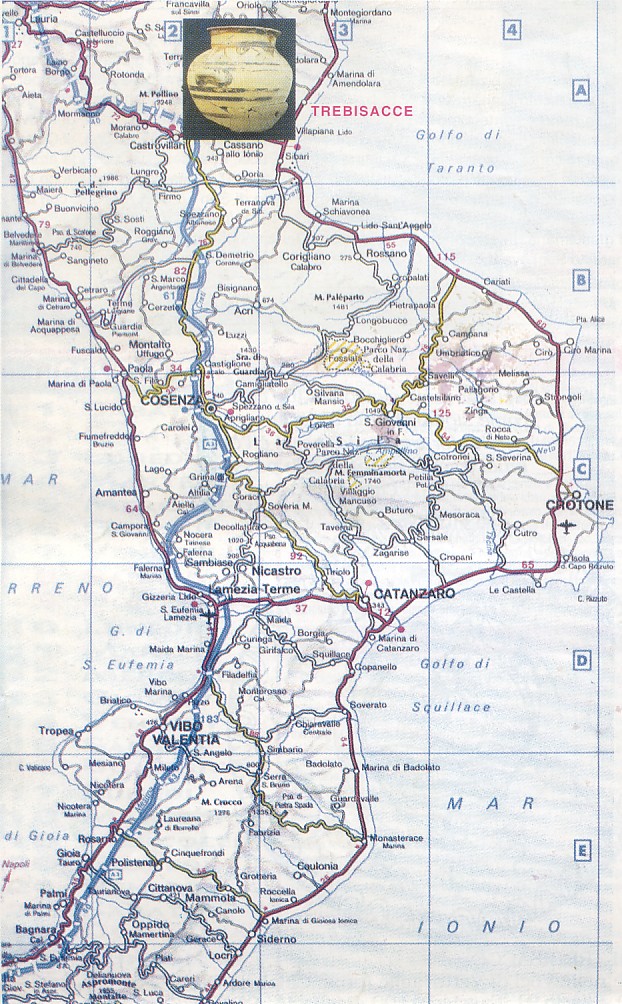
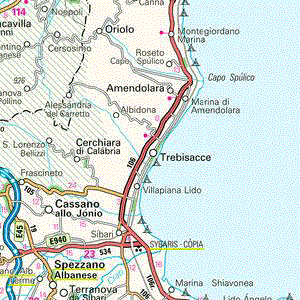
Trebisacce is situated on the North-East coast of the Ionian sea , precisely in the Northern part of the Sybaris Plains.
The territory is characterized by a coastal strip, terraces and hills. The town is 77 metres above sea level and with Mount Mostarico it reaches 774 metres of altitude. It covers an area of 26, 65 sq.Km with a population of 10.000 inhabitants, the coast line is 8 km. long.


How to get here:
Roads :
Coming from North: A3 exit Frascineto- SS 105- crossroads Torre Cerchiara- SS 106 up to Trebisacce.
Coming from South: A3 exit Sibari- SS 534- SS 106 up to Trebisacce
Trains :
FS long distance Sibari train station- Trebisacce local train station.
Bus lines :
from Cosenza, Sibari, Bari, Rome, Milan, Florence, Siena, Lucca, Pisa, Pistoia, Perugina, Bologna, Genoa, Modena, Turin.
Airports :
Lamezia Terme, Sant’Anna di Isola Capo Rizzuto, Bari.
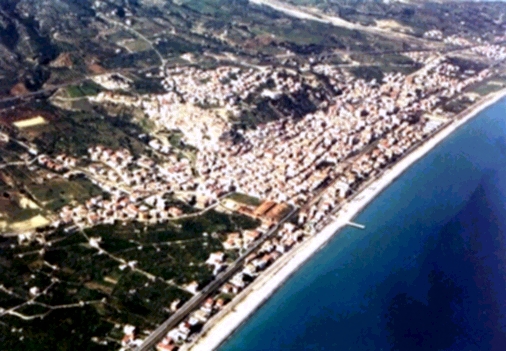 |
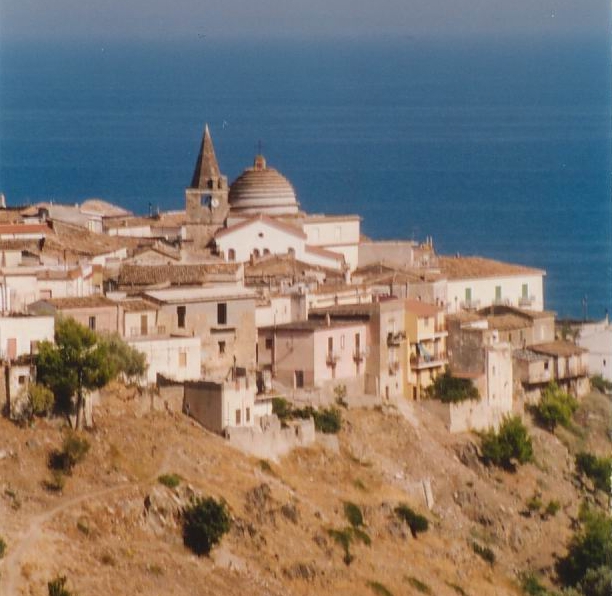 |
Trebisacce aerial view,
Ionian Coast line |
Historical centre
view, St. Nicholas of Myra church dome |
The town consists of two parts: the old one commonly called “ Paese” ( historical centre) and castled on a plateau; the lower one , known as “ Marina” is, instead, situated along the coast line.
The old village is surrounded by walls erected in the XVI century to defend the place by Saracens’ raids. Once the rampart, called by local people "Bastione”, had four entrance doors: St. Leonard, The Annunciation, St. Martin, and St. Anthony. It has been defined “the balcony of the Alto Ionio”, as a matter of fact from here you can enjoy an extraordinary panorama.
You can also easily see two Saracens’ towers whose function was to spot Saracens’ arrival: one is found in Albidona’s territory and the other in Villapiana’s that together with the Bastione and other spotting places represented the defensive system against pirates’ attacks.
The church og st. Nicholas of Myra is of a great historical interest. It was erected in the Byzantine period in 1040 and later, it was restored in baroque style with the typical bent tiles set in circles around the dome and the Basilian bell tower of the XII century with its distinctive internal pendenctives.
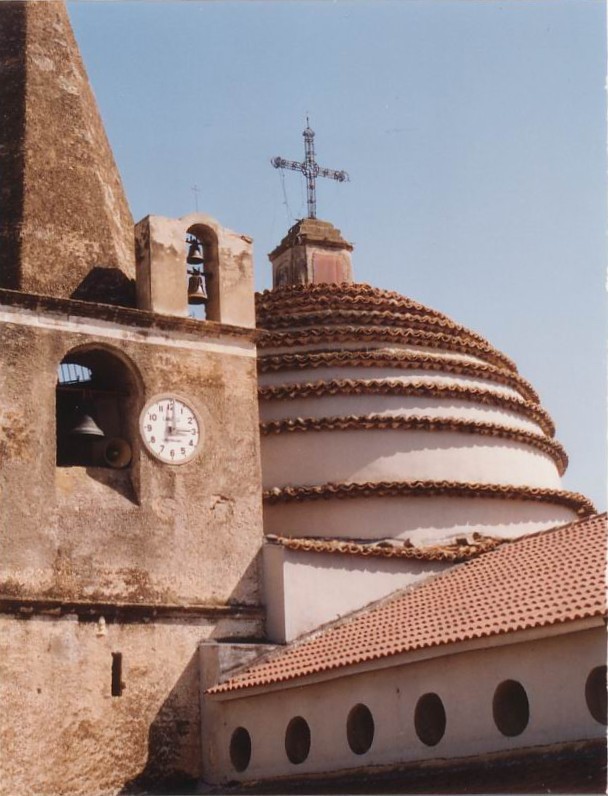 |
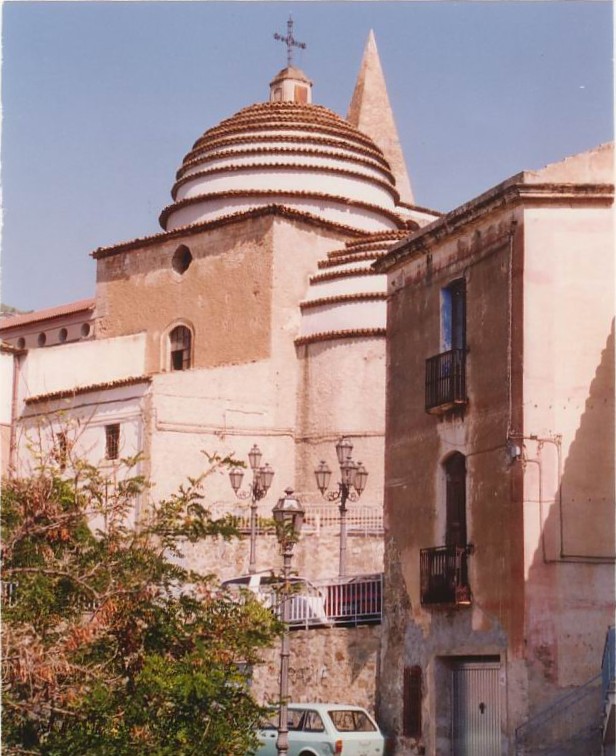 |
The new part of the town, the “Marina”, consists of a few country residences of the early Marina of Trebisacce built around 1900 and prior to those the construction of two taverns: Pucci’s tavern frequented by mountain people coming from Basilicata looking for seasonal jobs and Chidichimo’s tavern with a warehouse where the town workers used to step in for a drink.
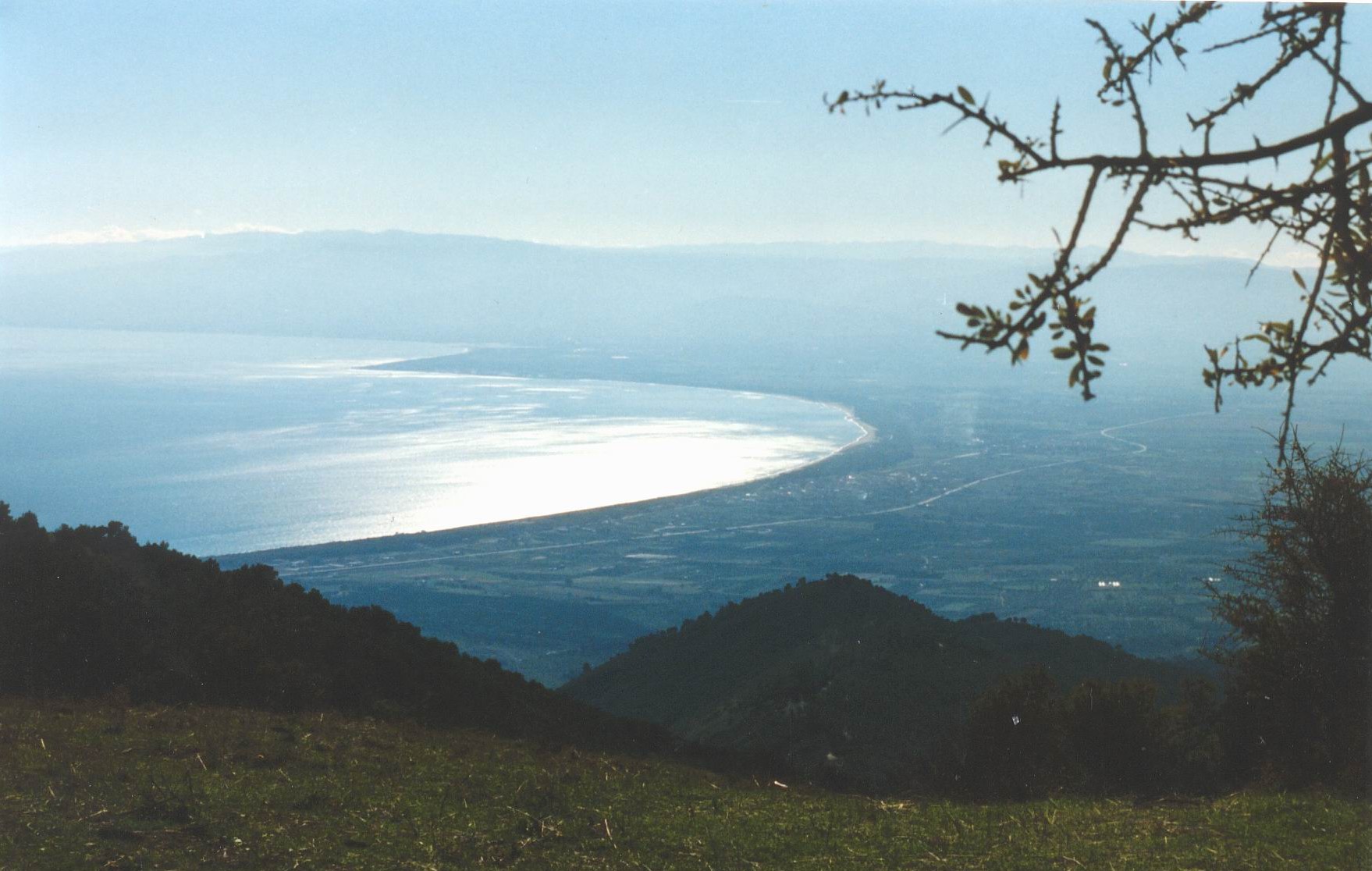
Sybaris Plains aerial view
In 1985 the Aletti’s building was built as a bathing establishment, later donated by the owner to the Town Hall and at present the seat of IPSIA “E. ALETTI”.
Next to the old buildings and with the construction of the railway, new houses were built changing so the scenario of the coast line : olive groves were slowly disappearing to meet the demand of a boosting housing market.
Buildings, shops, service offices, sports facilities, banks, post-offices, schools, the hospital, hotels, restaurants have been built and there is also a beautiful boardwalk with palm trees which is 3 km. long and offers a suggesting evening sight: the magnificent Gulf view with the fishing lights lighting the night.
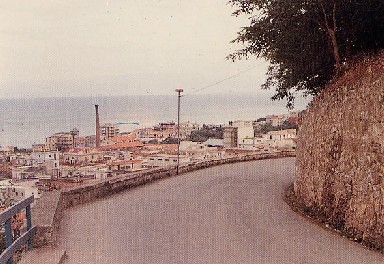
View form the Rampart
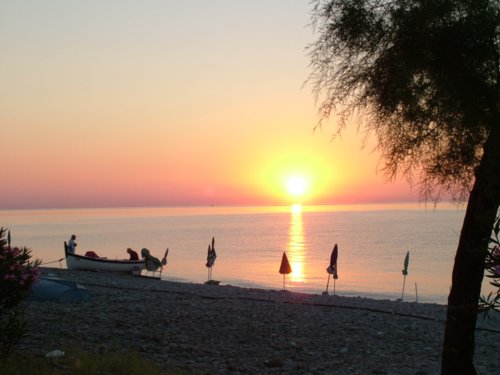
Warf, picture from the Riviera dei Saraceni boardwalk

Historical news
The word Trebisacce comes from the Byzantine language Trapezàkion “small table” and it is evident the historical reference to the tableau where the old village was built.
All historians and linguists agree on the origin of its name: from Alessio to Rholfs, from Caracausi to Trumper-Di Vasto-De Vita and Laviola.
Trebisacce is mentioned in two important documents of the XII century: the first one is a donation dated 1116 with which Alexander of Chiaromonte gave the territory of Trebisacce to the diocese of Cassano; the second one is a marriage contract which dates 1196 where the toponym de Trapezacio is defined and is reported the name of a citizen of that place.
In far-off times the territory , as the archeological remains testify, registers the presence of human settlements. It is of great interest the site in Broglio area where it has been dug out a protostoric village and findings which date back to the Middle Bronze Age and to the First Iron Age.
With the Greek settlement a very active communication network between the different polis was born ( Sybaris, Metaponto, Siris, Crotons, Locri, Taranto). Particularly the indigenous already well advanced made benefits by trading and by the influence that the colonies exercised with their traffics, their customs, their religion and their art.
The maritime traffic of the polis was made active by a thick road network of which we know the old road maps of Sibari-Campo Tenese-Lao, Sibari-Crotone, Sibari-Esaro-Belvedere, Sibari-Taranto. The last one started from Taranto touched Metaponto, Heraclea, Siris and reached Sybaris. It was this road which touched Trebisacce Marina to make the fortunes of Trebisacce. The town got the raw material, and of first quality, the clay of Vitraro district used to manufacture bricks and by ceramists: artisans’ workshops were flourishing for pottery production. Besides, its excellent strategic position with a possible retreat on Mount Mostarico and its closeness to the sea, like today, made it a regular checking and stopping point for the only way of communication between Metaponto and Sybaris.
With the Romans conquering the Magna Graecia there was an economic decay due to changes in the political and administrative structure of the Sibaritide.
Archeological documentation of the Roman times in Trebisacce’s area is irrelevant.
In the Byzantine period the only monument worth mentioning is the church of St. Nicholas of Myra and the bell tower. It is in this period that the town starts being called Trapezàkion from which its name derives.
From then on Trebisacce becomes a feud and passes from landlords to landlords.
In 1576 the town suffered one of the cruellest Turks'attacks (10.000 Turks). The town made up of only 500 people, although inferior in number fought bravely for three days succeeding in driving away the invaders; the troops sent by the prince of Bisignano got there only towards the end of the battle.
After the prince of Bisignano the next princes, dukes and barons followed one another in the Trebisacce territory.
In 1807 the French administrative rearrangement include it as a university (place) in the govern of S. Lorenzo Bellizzi. In 1874 it was transferred in the district of Amendolara and declared an autonomous municipality.
Broglio of Trebisacce
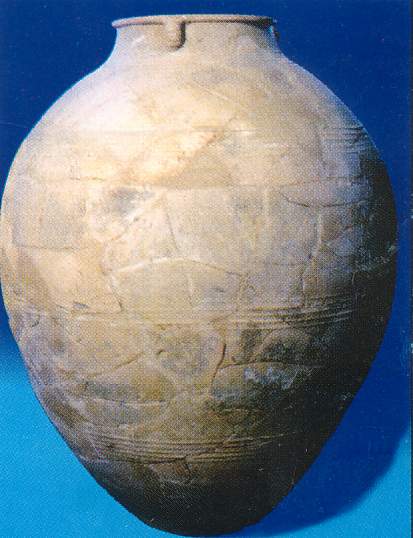
The archeological site has been spotted in 1978 by PH.D Renato Peroni of “La Sapienza” Rome University.
The excavations started in 1979 and are at present coordinated by the chair of European Protohistory of Rome University.
The first stage of life: Middle Bronze Age
The findings testify the existence of a protostoric village inhabited by Enotri people whose life goes from 1770 to 100 century B.C., from the Middle Bronze Age to the Iron Age. The build –up area was organized on terraces where huts were built and that, hélas, during the centuries they have been damaged by following farming activities.
Contact with the Aegean World
From the end of the Bronze Age and for all the recent Bronze Age, the local population makes direct contacts with the Mycenean sailors. Groups of Aegean artisans get into Sibaritide communities and groups of Enotri travel towards Greece.
New technologies are acquired : for the first time in Italy lathe is utilized to manufacture pottery in purified and painted ceramic. Vases similar in shape and decoration patterns to the Mycean ceramic are made to contain precious drinks. For the first time big jars “doli” are used to store oil and grains and they are similar to those found in Mycean Palaces. This testifies the colture of olive tree since ancient times.
The second 500 years in the village
With the Final Bronze Age the contacts with the Aegean people stop. Aristocracy takes a strong warlike mark and surrounds the acropolis of a massive fortification : a wall made of stone and wooden elements reinforced by a rampart in front of which a ditch 10 m. large and 4 m. deep opens up covered , at the foot of the wall, with a pavement in stones which has been restored many times.
The aristocratic élite also controlled the most important artisan activities such as iron working. In fact, in the acropolis of Broglio it has been dug out one of the most ancient forge which date back to the Bronze Age. In the Iron Age the contacts with Greece and the Phoenicians resume more and more intensely : fragments of painted cups and a scarab has been found on the last pavement of the ditch.
Similar evidence come from the acropolis of Terra Mordillo e Francavilla Marittima.
Around 710 B.C. the Greeks imposed their rule on all the region and founded the city of Sybaris.
The Enotri indigenous were subjected and forced to abandon their villages (except for Francavilla and Amendolara) and farm the watered land for the Sybarites.
Broglio Archeological Park
The park will be structured in a didactic way to allow the visit of a village made up of huts and other living structures such as warehouses or workshops. It will be shown a cross-section of Enotri’s community who lived on the Broglio hill in the second Millennium B.C.
The museum will host Mycenean style-like vases characterized by stylized vegetable patterns, the huge “ doli”, the finds of Phoenician import. There will also be exhibited finds of other areas of Trebisacce.
THE ECONOMY
Citrus trees have always been at the base of local economy and the oranges produced here are still exported all over Italy. The type of orange grown here is called “il biondo” ( the blonde) which differs from other kinds because it is available when the others are not any more in season that is its maturing time is in late Spring and it is also a very juicy orange. There are a great number of agri-farm which use this citrus fruit to put on the market first quality preserved fruit.
Another line of business is fishing. Every day motor trawlers and fishing boats sail to come back in the evening with the catch of fish. The fish market of Trebisacce is a reference point for all fishermen of the Ionian coast line.
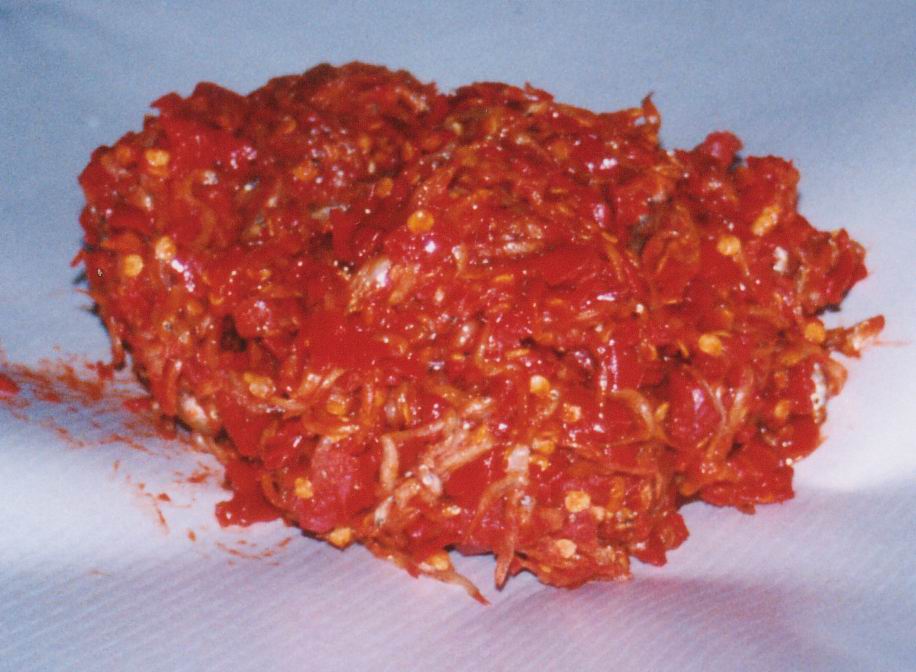
The construction of the railway (end of XIX century) gave a strong drive to the local economy with the flourishing of many cheese-food processing industries, the building contractors and the mostly the warf for being a trade landing place and for fishing boats docking.
Commercial business have developed , too: shops, public services, tourism offices, social services, sports facilities , hotels and restaurants. These are the first signs of changes from an agri-fishing economy into a service economy.
Trebisacce becomes a service town in the ‘80s of last century: there is an increase in the number of schools , the birth of service industries ( Health service, bus service).
New industries spring up:
|
|
“Bioagrumi e Solefrutta” , orange-food processing industries. |
|
|
“Miele Carlicillo”, apicolture industry, Tufaro Carmela agri-farm. |
|
|
“Garoppo fish Workshop” where it is utilized old sailor’s fish preserving methods by the use of Calabrian chilli pepper such as in the “nudicella” dish known also as “rosamarina”, the famous poor peoples’caviar. |
ORANGE ORCHARDS
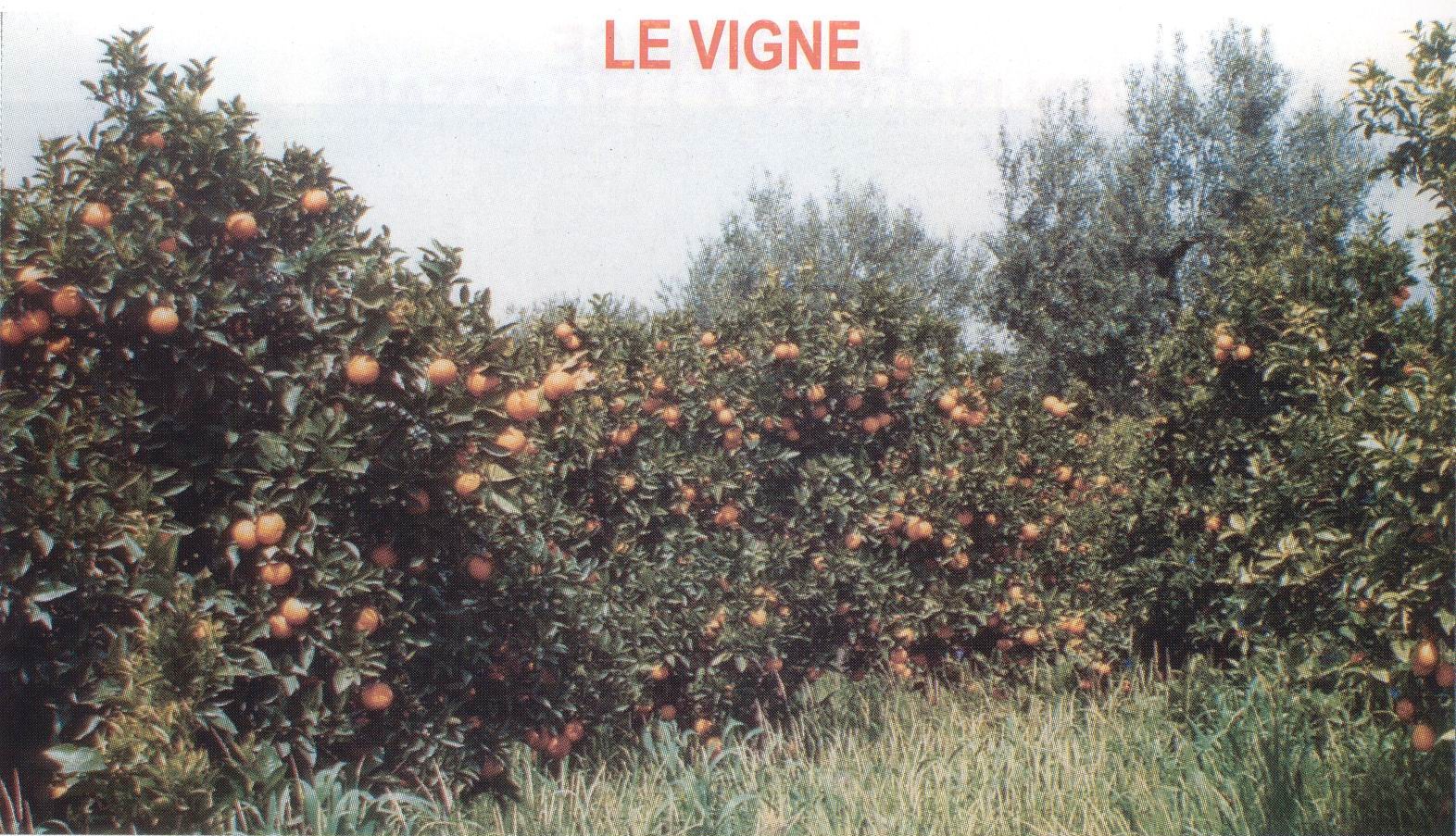
Citrus orchards( oranges and lemons) are the main resource in agriculture sector. They are found in the “vigne” (vineyards) an area comprised between the bank of Saraceno stream, the motorway 106 Jonica , the Paese of Trebisacce and Marzuca district.
The term “ vigna” is still used because prior to the cultivation of citrus trees , grapevine was grown. The vigna owners were called “vignaruoli”.
There is a variety of orange “il biondo” (the blonde) which is appreciated for its organoleptic values.
Until 1960 the selling of the fruit was made by “thousands” today, instead, is made by kilos or “a muzzo” that is , the quantity is valued at a guess. The orchards are measured by “cozza” that equals to 100 square metres. Gutters , “lacquari”, are found along orchards whose water is used by the vignaruoli to water the plants.
Celebrations
Tersicore Prize- April
Literature prize for the students of Trebisacce and School District.
Unitalsi Day- Spring
It is devoted to old and sick people with solidarity activities.
Summer in Trebisacce- July- August
Kermesse with cultural events, theatrical performances, music concerts, dancing contests and sports meetings.
“The Bastione” cultural Prize- August
It is conferred to those people who emerged in different business sectors and professions.
Festivals
Country Festival- 19th March
People feast in the pine and olive trees pick-nick area near the Chapel of St. Joseph. They bring homemade food: lasagne, cheeses, meat to be barbecued and wine. Lupins and blessed rolls are a must.
Fish Festival- August
Marinated and fried blue fish with Calabrian flavours is offered by the sailors on the warf and at the Kiosque square.
Fairs
St. Leonard Fair-6th November
It is the fair where local agri-products are sold. Figs are the best food sold (“serte” -threads- and “tascarelle” -pocket form- types).
St. Rocco- 16th August
In the morning mess is celebrated in St. Nicholas of Myra church. In the afternoon procession at sea between worshipers and boats. In the evening music concerts, entertainments , and stalls.
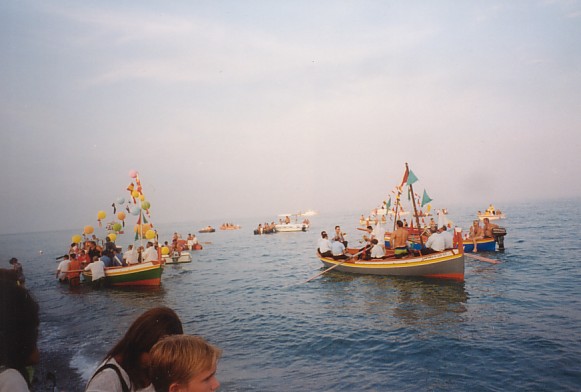
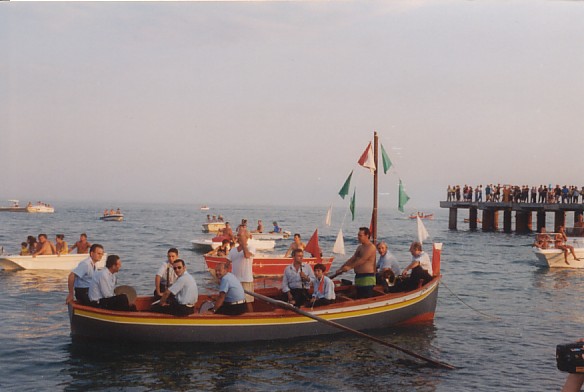
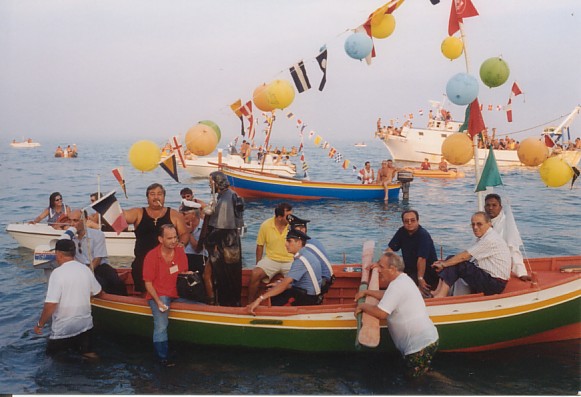
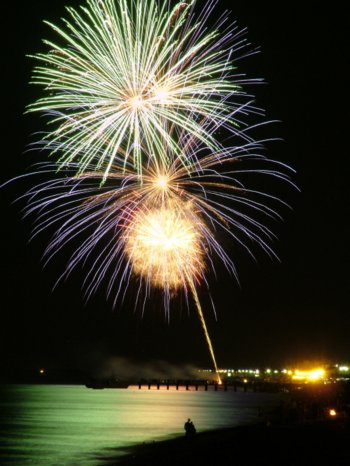
Market
Monthly market – the last Sunday
Big market held in the Marina with all kinds of items and with people coming from other regions to buy and to sell.
Sports
Sports Trophy Deliart Usalt – Spring
Regional yearly meeting for track-and-field events.

Origin and spread of olive tree in Italy